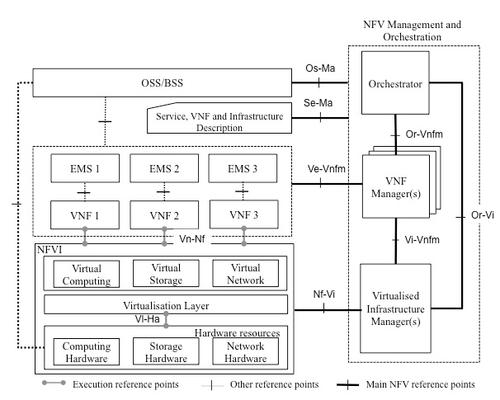Nfv Network

Network Functions Virtualization (NFV) is a core structural change in the way telecommunication infrastructure gets deployed. This in turn will bring significant changes in the way that applications are delivered to service providers.
Nfv network. NFV, by contrast, is all about the network functions that must be performed at all levels and stages of a network – at the periphery, boundary and core – to accept, forward, shape and filter network traffic as it courses through any given infrastructure. There are several important points about NFV to note: Network Function Virtualization (NFV) By Kelly Hill on February 20, 2019 0 Service assurance challenges in virtualized, multi-cloud networks What are the challenges for service assurance — and visibility and observability — as networks evolve toward virtualization, multi-cloud environments… Here , We will see what is NFV & What benefits its brings to the Mobile Operators . NFV movement started with push coming from mobile service providers , In 2012 , These 12 Tier-1 Operators felt that they can greatly simplify their operations and reduce cost if all network functions are virtualized as software appliances . Key enabling technologies for this vision include SDN (Software Defined Networking) and NFV (Network Functions Virtualisation). SDN and NFV are complementary but increasingly co-dependent. While the former provides the means to dynamically control the network and the provisioning of networks as a service, the latter offers the capability to.
Network Functions Virtualization (NFV) is the decoupling of network functions from proprietary hardware appliances and running them as software in virtual machines (VMs). The different functions. Networking professionals sometimes use the terms virtual network functions, or VNF, and network functions virtualization, or NFV, interchangeably, which can be a source of confusion.However, if we refer to the NFV specifications the European Telecommunications Standards Institute, or ETSI, sets forth, it becomes clear the two acronyms have related but distinct meanings. NFV is a means of abstracting network functions, allowing them to be installed, controlled, and manipulated by software running on standardized compute nodes. This technique incorporates cloud and virtualization technologies to rapidly develop new network services that are both automatic and scalable. NFV layout. The first released version of ETSI GS NFV-SOL 016 addresses five selected key NFV-MANO procedures, namely on-boarding of a VNF package, instantiation of a network service, termination of a network service instance, scaling of VNF instances in a network service instance and changing the external connectivity of VNF instances in a network service.
NFV makes networks more scalable, agile and efficient by allowing users to replace dedicated network function appliances with functions instantiated as virtual machines running on a server. Both NFV and SDN work to address overall network complexity, but they do so in different ways and accomplish very different things. Network Funtions Virtualization (NFV) adalah konsep arsitektur jaringan yang menggunakan teknologi virtualisasi untuk memvirtualisasikan seluruh fungsi platform jaringan dan fungsionalitas hardware. Secara sederhana, NFV mampu menawarkan fungsi, jaringan, dan infrastruktur jaringan sebagai sebuah layanan, bukan sebagai sebuah fitur di dalam. When Network Functions Virtualization, or NFV, came to public attention several years ago, it was touted as a disruptive technology that would eliminate many of the challenges associated with traditional hardware-centric networks—such as vendor lock-in, forklift upgrades, and built-in performance, scale, and service constraints. NFV Platform Requirements. The NFV architecture is designed augment or replace traditional, highly reliable network appliances. Thus, NFV must deliver the following. High performance to 100Gbps and up
Realize 360-degree network visibility with automatic topology discovery, converged overlay and underlay visibility, and real-time network insights. Telco Cloud Infrastructure Next Evolution of vCloud NFV Towards Cloud-Native Cisco Network Functions Virtualization (NFV) Build your edge computing foundation. Introduce services faster, deliver high quality user experience, and scale on demand even to unpredictable traffic models. View interactive infographic; Watch video (1:13) Transform your network and operations with NFV. The MarketWatch News Department was not involved in the creation of this content. Sep 21, 2020 (The Expresswire) -- Global "Network Function Virtualization (NFV) Market" (2020-2025) research. Network functions virtualization (also network function virtualization or NFV) is a network architecture concept that uses the technologies of IT virtualization to virtualize entire classes of network node functions into building blocks that may connect, or chain together, to create communication services.. NFV relies upon, but differs from, traditional server-virtualization techniques, such.
The SDN and NFV Technology in Telecom Network TransformationMarket Report includes estimates of market value (million USD) and volume (M Sqm). Both top-down and bottom-up approaches are used to. Network functions virtualization (NFV) is an initiative to virtualize network services traditionally run on proprietary, dedicated hardware.With NFV, functions like routing, load balancing and firewalls are packaged as virtual machines on commodity hardware.Individual virtual network functions, or VNFs, are an essential component of NFV architecture. Address new demands with the power of virtualization and the cloud Our SDN and NFV innovations can help you embrace lean operations, become more agile, and meet the need for high-quality and on-demand network services. They let you use virtualization and dynamic cloud consumption models to leverage new efficiencies, seize emerging opportunities, and capture market share with differentiated. works: Network Function Virtualization (NFV) and Software Defined Networking (SDN). The inherent potential and recent advances in the area of NFV and SDN have made them being recognized as key technological enablers for the realization of a carrier cloud, which is a key component of the 5G system. NFV is being designed and developed.
NFV allows network operators to manage and expand their network capabilities on demand using virtual, software based applications where physical boxes once stood in the network architecture. This makes it easier to load-balance, scale up and down, and move functions across distributed hardware resources.



















